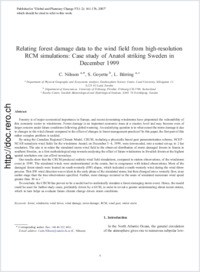Relating forest damage data to the wind field from high-resolution RCM simulations: case study of Anatol striking Sweden in December 1999
- Nilsson, C. Department of Physical Geography and Ecosystems Analysis, Geobiosphere Science Centre, Lund University, Sweden
- Goyette, Stéphane Department of Geosciences, University of Fribourg, Switzerland
- Bärring, L. Department of Physical Geography and Ecosystems Analysis, Geobiosphere Science Centre, Lund University, Sweden - Rossby Centre, Swedish Meteorological and Hydrological Institute, Norrköping, Sweden
-
03.01.2007
Published in:
- Global and Planetary Change. - 2007, vol. 57, no. 1-2, p. 161-176
English
Forestry is of major economical importance in Europe, and recent devastating windstorms have pinpointed the vulnerability of this economic sector to windstorms. Forest damage is an important economic issue at a country level and may become even of larger concern under future conditions following global warming. An underlying question is to what extent the storm damage is due to changes in the wind climate compared to the effect of changes in forest management practices? In this paper, the first part of this rather complex problem is tackled.By using the Canadian Regional Climate Model, CRCM, including a physically based gust parameterisation scheme, NCEP–NCAR reanalysis wind fields for the windstorm Anatol, on December 3–4, 1999, were downscaled, into a nested set-up, to 2 km resolution. The aim is to relate the simulated storm wind field to the observed distribution of storm damaged forests in Scania in southern Sweden, as a first methodological step towards analysing the effect of future windstorms in Swedish forests at the highest spatial resolution one can afford nowadays.Our results show that the CRCM produced realistic wind field simulations, compared to station observations, of the windstorm event in 1999. The simulated winds were underestimated at the coasts, but in congruence with inland observations. Most of the damaged forest stands were located on south-westerly (SW) slopes, which indicated a south-westerly wind during the wind throw process. This SW wind direction was evident in the early phase of the simulated storm, but then changed into a westerly flow, at an earlier stage than the true observations specified. Further, most damage occurred in the areas of simulated maximum wind speed greater than 30 m s− 1.To conclude, the CRCM has proven to be a useful tool to realistically simulate a forest damaging storm event. Hence, the model could be used for further study cases, preferably driven by a GCM, in order to reveal a greater understanding about recent storms, which in turn helps us evaluate future climate change driven storm conditions.
- Faculty
- Faculté des sciences et de médecine
- Department
- Département de Géosciences
- Language
-
- English
- Classification
- Meteorology, climatology
- License
-
License undefined
- Identifiers
-
- RERO DOC 8134
- DOI 10.1016/j.gloplacha.2006.11.011
- Persistent URL
- https://folia.unifr.ch/unifr/documents/300178
Statistics
Document views: 130
File downloads:
- pdf: 230
